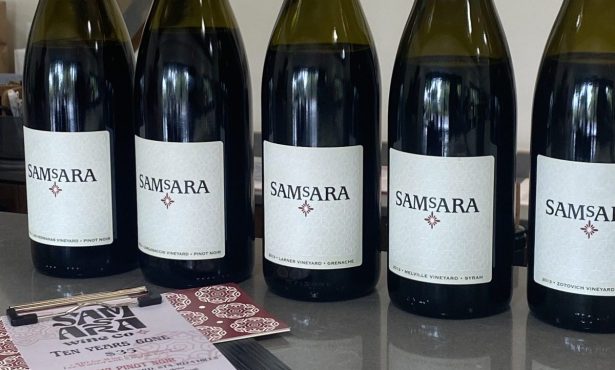Touchdown Wines
Cold Snaps and Port Wine
It’s been damn cold lately. The other night, it got down to 14
degrees here in Santa Ynez. It’s the kind of cold that chills one’s
blood and bones. Whenever there’s a real cold snap, I reach for a
good vintage port. Now, I’m not suggesting this will keep you warm
and safe throughout winter. Blankets, healthful food, and heat are
the best remedy for that. But, on those wintry nights when a hot
chocolate just won’t cut it, try a vintage — or even ruby — port,
and it should add some warmth to your hearth.
Ruby ports are cheaper than vintage ports and pretty readily
available. Simply put, a ruby port does not need to be from a
declared vintage. It’s an ordinary port aged for two to five years
in oak vats and it’s somewhat monolithic. There isn’t a lot of
mystery to a ruby port, but it pairs very well with most cheeses
and is great as a sipping wine. I tend to choose a ruby port when
I’m enjoying the latest episode of The Apprentice, after I’ve
finished dinner, and when all I want is a small glass of something
slightly sweet with which to close my evening. Warres and Cockburns
make a nice ruby port. It’s hard to go wrong with a ruby port from
Portugal, and you should be able to find one at most fine grocers
or wine shops in Santa Barbara.
For a truly memorable and heart-warming (literally) experience,
though, I recommend a good vintage port. Vintage ports are from
declared vintages. They are the great wines of the Douro region of
Portugal, and are only made in certain years. My favorite port
houses are Fonseca and Warres; both make vintage ports. Recent
vintages that are critical successes are the 1997 and 2000. Vintage
ports are more expensive and tend to start at around $46 for
current releases, but they are well worth the cost. They age
exceedingly well and demonstrate great complexity as they grow
older. But, even in their youth, vintage ports are deeply layered,
flavorful, and mysterious.
Tawny ports are also popular, though they are my least favorite.
They are slightly oxidized, on purpose, and, as a result, possess a
generally nutty flavor and are golden brown in color.
Once you’ve decided upon a port, you don’t need to worry about
consuming the bottle within a few days of opening it, as you would
with unfortified wine. Port is fortified with brandy, and, as such,
can last for a long while in a bottle even after it’s been opened.
Make certain that you use a good, solid stopper to enclose it.
You’ll find that even after several months, the port you opened is
still flavorful and sound. The longest I’ve had an opened bottle of
port was six months, and it lasted the entire time, retaining its
structural integrity.
Port is generally too sweet to pair with an entrée so it’s best
served after dinner. I often serve it in lieu of dessert,
especially after a big meal when guests tend not to have room left
for rich dessert. It’s best served at cellar temperature (around
55-60 degrees) and is best poured in smaller glasses. Try not to
use glasses that are too small, as you and your guests might find
it hard to enjoy the wines bouquet that way. But, a mid-sized glass
is perfect, with only a small bit poured for each guest.



